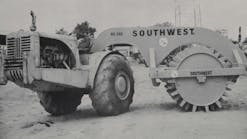In the mid 1960s, when building Blue River Dam on its namesake river in the Cascade Mountains east of Eugene, Ore., Lockheed Shipbuilding & Construction Co. chose some rather unusual machines for the work.
The dam is 270 feet tall; 1,265 feet long; and consists of 5,427,000 cubic yards of rockfill that was excavated from the riverbed upstream from the dam. One of the loaders was a Lima 2400. Introduced in 1948, the Lima 2400 was rated at 6, and later 8, cubic yards as either a shovel or dragline. Lockheed initially used its machine as a dragline, but for reasons unknown to this writer, the dragline was unsuitable for excavating below the water table. To handle that work, Lockheed ordered a custom backhoe front for the big rig.
Several other manufacturers of lattice excavators had offered hydraulic assist for large cable-operated backhoe fronts, usually to provide additional breakout force by allowing the bucket to pivot as on a hydraulic excavator; on a cable machine, the bucket was fixed to the dipper stick, and relied on the weight of the boom and stick, pulling power of the cables, and the physics of its motion through the cut for breakout force.
The largest of these machines in commercial production was the 6-1/2-cubic-yard 190DA, introduced by Northwest in 1975. But the custom backhoe front for the Lima 2400 was much bigger. Built by Albin Manufacturing Co. of Portland, Ore., it wielded a huge 12-cubic-yard Esco bucket. Hydraulic excavators of such capacity—and even far larger— followed in the late 20th century, but never again was there another cable backhoe of such prodigious size.
Some of the haulers were also massive, although not of an all-time-record size. Along with 13 Haulpak end dumps of conventional 35- and 50-ton capacity, Lockheed also used eight rare Wabco 120-ton-capacity bottom-dump trucks, which used a wagon drawn by a 75A Haulpak tractor. These were the first such machines built and remain the only Wabco bottom dumps in construction service (versus coal mining) that this author has learned of in extensive research.
Lockheed’s presence itself was almost as unusual as its choice of backhoe and bottom dumps. Its roots went back to the founding of Puget Sound Bridge and Dredging Co. of Seattle, founded in 1898 and purchased in 1959 by Lockheed. Operating as Lockheed Shipbuilding & Construction, its primary business was shipbuilding until closing in 1988.
The construction operations are much less well known. This author knows of only a handful of major projects besides the Blue River Dam that it undertook, including Reudi Dam in Colorado, 1964-1967; the Angeles Tunnel on the West Branch of the California Aqueduct, 1966-1970; the Belden, Calif., power tunnel and appurtenances, 1966-1969; Skookumchuck Dam in Washington, 1969-1970; and the main contract for the Grand Coulee Dam Third Powerhouse, 1970-1974. The Angeles and Grand Coulee projects were undertaken in joint venture.
The Historical Construction Equipment Association (HCEA) is a 501(c)3 non-profit organization dedicated to preserving the history of the construction, dredging and surface mining equipment industries. With more than 4,000 members in 25 countries, our activities include operation of the National Construction Equipment Museum and archives in Bowling Green, Ohio; publication of a quarterly magazine, Equipment Echoes, from which this text is adapted, and hosting an annual working exhibition of restored construction equipment. Our 2017 show will be November 3-5 at the Ederville Train and Tractor Show, Carthage, N.C. USA. Individual memberships within the USA and Canada are $35 for one year, $66.95 for two years, and $99.95 for three years, and $45.00 U.S. elsewhere. We seek to develop relationships in the equipment manufacturing industry, and we offer a college scholarship for engineering students. Information is available at www.hcea.net, or by calling 419.352.5616 or e-mailing [email protected].





